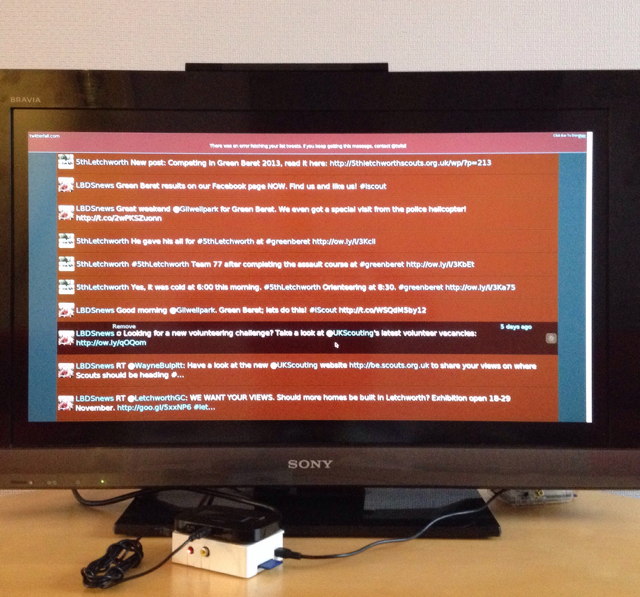Back on Deneb
I followed a similar procedure with the pools on deneb. The only change was that instead of running the second snapshot plus send/recv task with the system running normally, I ran it with the system running in no install/recovery mode. That way no services or zones were running.
After I had completed renaming, exporting and importing the pools, I rebooted as I had done with eridani. I immediately hit a problem: Smartos crashed at some point during the boot process. Unfortunately, the crash message scrolled off the screen before I could see what it was.
I rebooted and videoed the boot sequence on my ‘phone. There’s a kernel panic that causes the crash but it’s impossible to determine what the cause is.
On the basis that I can only really make progress with a running system, I decided to
- reboot into recovery mode
- destroy the the new pool
- import the old pool as
zzbackup - install SmartOS on to t a newly created pool
- try and debug from there.
I removed dsk3 (containing the zzbackup pool) and then reinstalled smartos on to a newly created raidz1 pool.
When I rebooted without dsk3 the system was stable. When I then rebooted with dsk3 installed, the system panicked again!
I rebooted into recovery mode, imported zzbackup and destroyed it.
Now it reboots OK. Now I can import the destroyed zzbackup pool on to an alternate mount point.
[root@deneb ~]# zpool status
pool: zones
state: ONLINE
scan: none requested
config:
NAME STATE READ WRITE CKSUM
zones ONLINE 0 0 0
raidz1-0 ONLINE 0 0 0
c1t0d0 ONLINE 0 0 0
c1t1d0 ONLINE 0 0 0
c1t2d0 ONLINE 0 0 0
logs
c1t4d0 ONLINE 0 0 0
errors: No known data errors
[root@deneb ~]# zpool import -D
pool: zzbackup
id: 11000531473529046782
state: ONLINE (DESTROYED)
action: The pool can be imported using its name or numeric identifier.
config:
zzbackup ONLINE
c1t3d0 ONLINE
[root@deneb ~]# mkdir /alt
[root@deneb ~]# zpool import -D -R /alt zzbackup
[root@deneb ~]# zpool status
pool: zones
state: ONLINE
scan: none requested
config:
NAME STATE READ WRITE CKSUM
zones ONLINE 0 0 0
raidz1-0 ONLINE 0 0 0
c1t0d0 ONLINE 0 0 0
c1t1d0 ONLINE 0 0 0
c1t2d0 ONLINE 0 0 0
logs
c1t4d0 ONLINE 0 0 0
errors: No known data errors
pool: zzbackup
state: ONLINE
scan: scrub repaired 0 in 4h47m with 0 errors on Tue Feb 6 22:32:20 2018
config:
NAME STATE READ WRITE CKSUM
zzbackup ONLINE 0 0 0
c1t3d0 ONLINE 0 0 0
errors: No known data errors
[root@deneb ~]# zfs mount
zones /zones
zones/archive /zones/archive
zones/cores/global /zones/global/cores
zones/var /var
zones/config /etc/zones
zones/opt /opt
zones/usbkey /usbkey
zzbackup/opt/data /alt/data
zzbackup/opt/data/backups /alt/data/backups
zzbackup/opt/data/cfg-backups /alt/data/cfg-backups
zzbackup/opt/data/dev_backups /alt/data/dev_backups
zzbackup/opt/data/home /alt/data/home
zzbackup/opt/data/home/git /alt/data/home/git
zzbackup/opt/data/media /alt/data/media
zzbackup/opt/data/public /alt/data/public
zzbackup/opt/data/software /alt/data/software
...
zzbackup/archive /alt/zones/archive
...
zzbackup/cores/global /alt/zones/global/cores
zzbackup /alt/zzbackup
Now I can rebuild deneb from the old system. A bit tedious though.
- Copied usbkey over and rebooted (had to destroy zzbackup first again though)
- Copied /opt over so that the custom services start up.
- Rebooted to be sure.
Before laboriously rebuilding, I decided to try booting with dsk3 as zones and the new pool as zznew.
It boots, but the mountpoints are screwed!
root@deneb ~ $ zfs list
NAME USED AVAIL REFER MOUNTPOINT
zones 2.67T 863G 588K /zones
zones/0246b0fe-771c-60ba-cbe6-92ea5795117b 1.21G 8.79G 1.27G /zones/0246b0fe-771c-60ba-cbe6-92ea5795117b
zones/088b97b0-e1a1-11e5-b895-9baa2086eb33 528M 863G 527M /zones/088b97b0-e1a1-11e5-b895-9baa2086eb33
zones/147f4eca-1783-4b80-d7e4-9a1d4420567a 294M 9.71G 432M /zones/147f4eca-1783-4b80-d7e4-9a1d4420567a
zones/163cd9fe-0c90-11e6-bd05-afd50e5961b6 257M 863G 257M /zones/163cd9fe-0c90-11e6-bd05-afd50e5961b6
zones/1870884c-780a-cb0b-fdc0-8e740afa4173 320M 9.69G 459M /zones/1870884c-780a-cb0b-fdc0-8e740afa4173
zones/1bd84670-055a-11e5-aaa2-0346bb21d5a1 52.2M 863G 51.9M /zones/1bd84670-055a-11e5-aaa2-0346bb21d5a1
zones/1ed69a26-f60b-401c-bde6-793df2d0547b 2.12G 498G 2.01G /zones/1ed69a26-f60b-401c-bde6-793df2d0547b
zones/2a9bfaf4-ddf1-e146-ab80-e2f8723ec714 313M 9.69G 453M /zones/2a9bfaf4-ddf1-e146-ab80-e2f8723ec714
zones/46c77656-5d22-cdaf-8056-88aaa11c1e58 790M 9.23G 868M /zones/46c77656-5d22-cdaf-8056-88aaa11c1e58
zones/4bc5b510-2d5d-e47e-c3bc-d492dfeae320 813M 9.21G 813M /zones/4bc5b510-2d5d-e47e-c3bc-d492dfeae320
zones/4bc5b510-2d5d-e47e-c3bc-d492dfeae320-disk0 53.9G 903G 11.1G -
zones/5c7d0d24-3475-11e5-8e67-27953a8b237e 256M 863G 256M /zones/5c7d0d24-3475-11e5-8e67-27953a8b237e
zones/7b5981c4-1889-11e7-b4c5-3f3bdfc9b88b 241M 863G 240M /zones/7b5981c4-1889-11e7-b4c5-3f3bdfc9b88b
zones/842e6fa6-6e9b-11e5-8402-1b490459e334 226M 863G 226M /zones/842e6fa6-6e9b-11e5-8402-1b490459e334
zones/a21a64a0-0809-11e5-a64f-ff80e8e8086f 186M 863G 186M /zones/a21a64a0-0809-11e5-a64f-ff80e8e8086f
zones/archive 152K 863G 88K none
zones/b33d4dec-db27-4337-93b5-1f5e7c5b47ce 792M 863G 792M -
zones/c8d68a9e-4682-11e5-9450-4f4fadd0936d 139M 863G 139M /zones/c8d68a9e-4682-11e5-9450-4f4fadd0936d
zones/config 468K 863G 196K legacy
zones/cores 250M 863G 88K none
...
zones/cores/global 152K 10.0G 88K /zones/global/cores
...
zones/dump 260K 863G 140K -
...
zones/opt 2.50T 863G 1.20G legacy
zones/opt/data 2.49T 863G 112K /data
zones/opt/data/backups 617G 863G 466G /data/backups
zones/opt/data/cfg-backups 57.2G 863G 47.8G /data/cfg-backups
zones/opt/data/dev_backups 2.61G 863G 2.61G /data/dev_backups
zones/opt/data/home 108G 863G 108G /data/home
zones/opt/data/home/git 152K 863G 88K /data/home/git
zones/opt/data/media 1.73T 863G 1.73T /data/media
zones/opt/data/public 172K 863G 108K /data/public
zones/opt/data/software 336K 863G 272K /data/software
zones/swap 33.2G 896G 246M -
zones/usbkey 196K 863G 132K legacy
zones/var 1.05G 863G 1.03G legacy
zznew 37.6G 3.47T 1018K /zznew
zznew/archive 117K 3.47T 117K /zznew/archive
zznew/config 139K 3.47T 139K legacy
zznew/cores 234K 3.47T 117K none
zznew/cores/global 117K 10.0G 117K /zznew/global/cores
zznew/dump 1.84G 3.47T 1.84G -
zznew/opt 2.88G 3.47T 2.88G legacy
zznew/swap 32.9G 3.50T 74.6K -
zznew/usbkey 261K 3.47T 261K legacy
zznew/var 3.91M 3.47T 3.91M /zznew/var
This may be the cause of the panic
The salient parts are:
root@deneb ~ $ zfs list
NAME USED AVAIL REFER MOUNTPOINT
zones 2.67T 863G 588K /zones
zones/archive 152K 863G 88K none
…
zones/config 468K 863G 196K legacy
zones/cores 250M 863G 88K none
…
zones/cores/global 152K 10.0G 88K /zones/global/cores
…
zones/dump 260K 863G 140K -
…
zones/opt 2.50T 863G 1.20G legacy
…
zones/swap 33.2G 896G 246M -
zones/usbkey 196K 863G 132K legacy
zones/var 1.05G 863G 1.03G legacy
zznew 37.6G 3.47T 1018K /zznew
zznew/archive 117K 3.47T 117K /zznew/archive
zznew/config 139K 3.47T 139K legacy
zznew/cores 234K 3.47T 117K none
zznew/cores/global 117K 10.0G 117K /zznew/global/cores
zznew/dump 1.84G 3.47T 1.84G -
zznew/opt 2.88G 3.47T 2.88G legacy
zznew/swap 32.9G 3.50T 74.6K -
zznew/usbkey 261K 3.47T 261K legacy
zznew/var 3.91M 3.47T 3.91M /zznew/var
root@deneb ~ $ zfs mount
zones /zones
…
zznew /zznew
zznew/archive /zznew/archive
zznew/cores/global /zznew/global/cores
zznew/var /zznew/var
zznew/config /etc/zones
zznew/opt /opt
zznew/usbkey /usbkey
As you can see, some of the legacy datasets on zznew are being mounted instead of the equivalents from zones. i.e. it seems to be mixing up the legacy mounts.
yet more to follow



